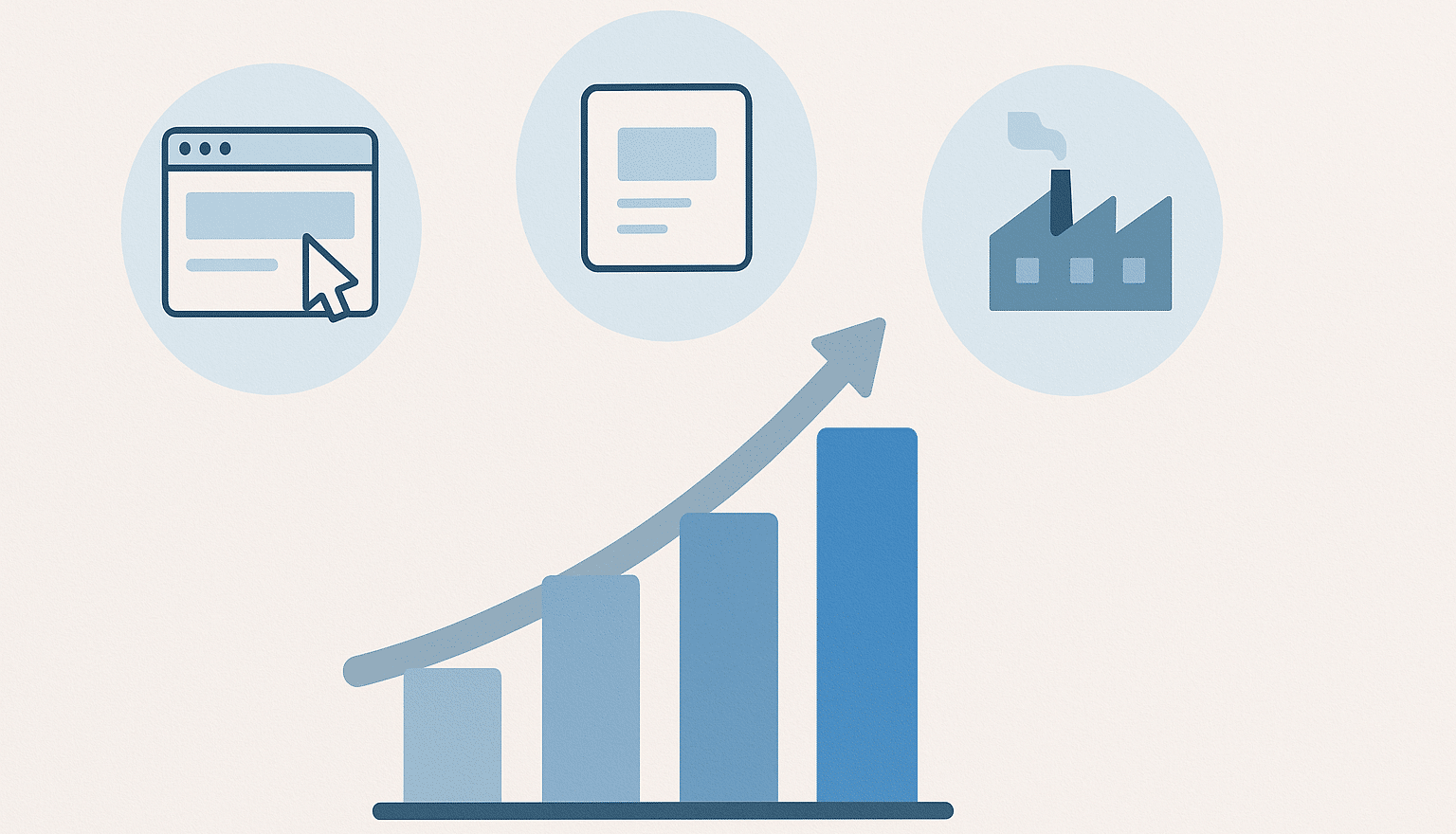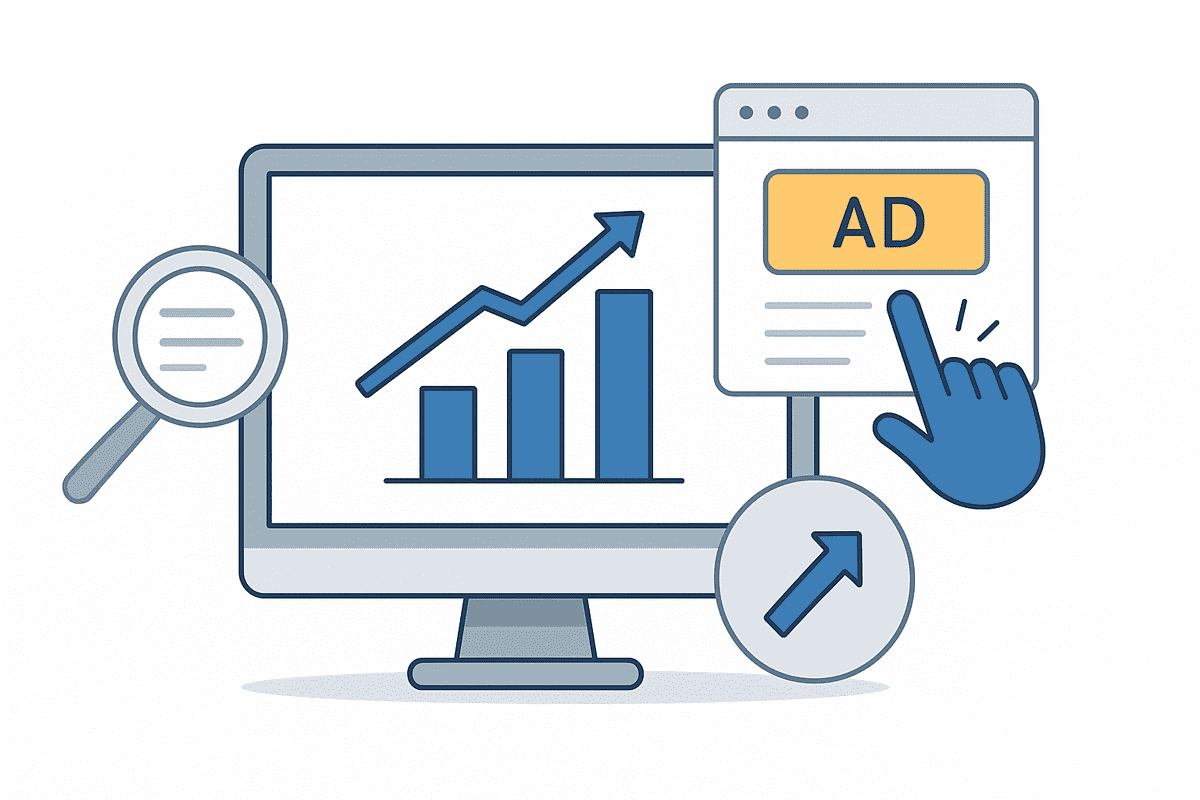Click-through rate (CTR) is the percentage of users who click on a link, ad, or search result out of the total number of times it is seen. It helps measure how well online content or campaigns get people to take action. The formula is simple:
CTR = (Clicks ÷ Impressions) × 100
If 100 people see an ad and 3 click on it, the CTR is 3%. This number shows how effective the content is in catching user attention. It is used across digital marketing, search engine advertising, email campaigns, and social media links. A higher CTR means more people found the message useful or interesting.
Key points:
- Impression means a single view of a link or ad.
- Click is when someone taps or selects that item.
- CTR compares these two to track engagement.
- It is used in SEO, PPC, and display ad performance.
This metric gives a neutral, number-based view of how well a message performs, without personal opinion or guesswork.
Use of Click-through Rate in Digital Contexts
Click-through rate (CTR) is used in many online areas to check how well a link, ad, or content attracts clicks. It is one of the most common ways to measure user engagement and content performance in real time.
Online advertising and campaign testing
In online advertising, CTR is tracked to see how well an ad connects with people. It works across ad types like:
- Search engine ads
- Banner ads
- Video ads
- Shopping display cards
A higher CTR in digital ads means more users found the message clear, helpful, or interesting. Advertisers often compare CTRs to decide which ad copy, image, or format works best. This helps improve ad quality and lower costs per click.
CTR in search engines and user behavior
Search engines also use CTR as a ranking signal. When a user clicks on a result more often than others, it shows that the result may match the search intent well. If a link gets fewer clicks even when shown high up, it might get moved down later. In this way, CTR shows result relevance and how helpful it feels to the user.
Email marketing and campaign tracking
In email marketing, CTR tells how many people clicked a link inside a mail. It is different from open rate, which only tracks if the email was opened. High CTR in email means the message or subject was strong enough to make people take action. Marketers often run A/B tests to compare different emails and improve click results.
Analytics, content strategy, and public use
Because it is easy to measure, CTR is a standard in web analytics. Companies use it to compare different posts, ads, or messages. It works for both commercial and public services. For example:
- An e-commerce site tracks CTR for product ads
- A health agency tracks CTR for a link to vaccine info
- A news portal watches CTR on headlines or story links
CTR gives a neutral, number-based view of what users click and what they skip. It supports better content decisions, makes targeting sharper, and helps reduce waste in digital outreach.
History and evolution of click-through rate
Click-through rate (CTR) came into use with the rise of the World Wide Web in the 1990s. Before that, ads in newspapers, TV, or radio were measured by how many people responded, like sending back coupons or making phone calls. There was no way to track instant user action until web ads made it possible.
The first web banner ad appeared in October 1994 on HotWired.com, the website of Wired magazine. The ad, made by AT&T, asked users: Have you ever clicked your mouse right HERE? … You WILL. It reached a click-through rate of 44%, meaning nearly half the viewers clicked on it. This was a rare moment in internet history when ads were still new and people were curious.
As the web filled with more ads in the late 1990s, CTR dropped sharply. Users started ignoring ads, a pattern now called banner blindness. By the early 2010s, the average CTR for display ads had fallen to just 0.1% or 0.2%. That means only one or two clicks per thousand views. These numbers are still typical in many ad formats today.
Pay-per-click and Quality Score models
The late 1990s brought in pay-per-click advertising (PPC), first by GoTo.com, then later by Google through AdWords. In this model, advertisers only pay when someone clicks on their ad. That made CTR more important. A higher CTR meant:
- More traffic for the same cost
- Better Ad Rank in search results
- Lower cost per click (CPC) due to higher Quality Scores
Google’s Quality Score algorithm rewards ads that get more clicks compared to others in the same space. This helped CTR shape both pricing and placement in online ad auctions.
CTR in the modern digital space
Today, CTR remains a key metric across many platforms, including:
- Search engine ads
- Display networks
- Email campaigns
- Social media promotions
However, as digital marketing became more complex, the limits of CTR became clear. New metrics like conversion rate and view-through rate are now used along with CTR to understand the full picture of how ads perform.
Concept and measurement of click-through rate
Click-through rate (CTR) shows how many people click on a link out of everyone who saw it. It is written as a percentage and gives a quick idea of how well a message or ad works online.
How CTR is calculated
The formula for CTR is:
CTR = (Number of clicks ÷ Number of impressions) × 100
If an ad gets 20 clicks out of 1,000 views, the CTR is 2%. The result is often written with two decimal places, like 0.35% CTR.
- An impression is counted when a link, ad, or result shows up on a screen.
- A click is counted when someone taps or clicks that item.
CTR can be measured for a single link or for a full campaign. It helps compare different ads, messages, or channels quickly.
What high or low CTR means
- A high CTR means more people clicked, which usually shows the message is clear or well-matched to the audience.
- A low CTR means fewer people clicked, which could mean the ad was not shown to the right people or the message was weak.
However, what counts as “good” depends on where the ad runs. For example:
- A strong CTR in emails could be over 3%
- The same number in banner ads may be considered high if it is even 0.5%
CTR is a type of engagement rate that shows interest from a viewer. It works like a simple probability: the chance someone will click after seeing something online.
CTR and other performance metrics
CTR only tracks clicks. It does not measure what happens after someone clicks. For that, there are other metrics like:
- Conversion rate: how many clicks lead to actions like buying or signing up
- View-through rate: how many people view the ad but take action later
For example, an ad may have a high CTR but low sales, which means people clicked but did not find what they needed.
Still, CTR is a key first step in tracking online behavior. It is widely used because the math is simple and the result is easy to understand.
Uses of click-through rate across digital platforms

Click-through rate (CTR) is used to measure how often users respond to digital messages. It is widely applied in both commercial advertising and non-commercial systems where tracking user clicks helps understand engagement and improve results.
Commercial advertising and performance testing
In online advertising, CTR is a core metric. It shows how many users clicked an ad after seeing it. For example:
- In pay-per-click search ads (like Google Ads), a high CTR means the ad copy or keyword is appealing
- In display ads (such as banners or videos), even a small rise from 0.1% to 0.2% CTR is considered meaningful
- On social media platforms, CTR tracks how many users click on sponsored posts
- In email marketing, a CTR of 3% means 3 in 100 recipients clicked a link inside the email
Marketers compare CTRs across ads and platforms to find which one works better. They also run A/B tests to try new versions and improve results. Many ad platforms reward high CTR ads with better positions or lower costs, which increases ROI (return on investment).
Search engines and algorithm feedback
In search engines, CTR helps engineers test how well results match user intent. For example:
- CTR shows which result people click most—like the first vs. second link
- If a result gets fewer clicks than expected, it may be moved down
- A result with a strong organic CTR often means its title and snippet are working well
CTR is not the only ranking factor, but it helps shape ranking algorithms over time based on user behavior.
Recommender systems and interface design
Recommendation engines (used on news websites or streaming apps) use CTR to improve what they suggest. For example:
- If a suggested video or article gets clicked often, the system shows it more
- If a link gets skipped, it may be removed from future lists
CTR also helps in user experience tests. Designers might show two versions of a page and see which one gets more clicks.
Public service and nonprofit outreach
CTR is used in health campaigns and social awareness ads. A public health group might:
- Post an online message about vaccines or safe habits
- Track CTR to see how many users clicked to learn more
If a campaign gets a CTR of 1.8%, that becomes a baseline to improve future outreach. A higher CTR shows the message is reaching the right people and encouraging action.
Limits and risks of using click-through rate
While click-through rate (CTR) is widely used in digital analytics, it has several important limits. A high CTR does not always mean success, and a low one does not always mean failure.
CTR does not reflect post-click success
CTR only measures how many people click. It does not track what happens next. For example, a catchy headline might get many clicks, but if users leave the site quickly or do not buy anything, the clicks have little value. This gap is why CTR is often paired with conversion rate to check real outcomes like sales or sign-ups.
High CTR can be misleading
Some content, such as clickbait headlines, may raise CTR but disappoint users. This leads to poor engagement after the click. In these cases, a high CTR gives a false picture of success if seen alone.
Context matters when comparing CTR
What counts as a “good” CTR changes across platforms:
- A 2% CTR in a display ad can be excellent
- The same CTR in an email campaign might be below average
So, comparing CTR across ad formats or industries without understanding the context can be misleading.
Click fraud and non-human traffic
Fake clicks from bots or click farms can raise CTR without any real interest behind them. This is known as click fraud. It wastes ad budget and inflates reports. Studies have shown that up to 45% of internet traffic may come from bots. Even with fraud filters in place, advertisers need to watch for signs like:
- High CTR with zero conversions
- Very short page visits
These signs may point to invalid clicks or low-quality traffic.
Many users ignore banner ads over time, a habit called banner blindness. Even well-designed ads may show CTR below 0.1%, not because they are bad, but because people are used to skipping them. This makes CTR a weak measure for brand awareness or long-term impact.
Placement bias and visibility effects
CTR is also affected by where a link appears:
- A top-position search result gets more clicks than a lower one
- A banner high on a page performs better than one at the bottom
So, raw CTR can be biased by layout or placement. Many platforms now use adjusted CTR, which compares a result to average CTRs for similar spots or keywords, to measure actual performance.
Strategic impact of click-through rate in digital marketing
Click-through rate (CTR) plays a major role in shaping how digital campaigns are planned, tested, and optimized. Even with its limits, CTR directly affects ad performance, placement, and cost in many platforms.
Role of CTR in ad ranking and cost
In Google Ads and similar platforms, CTR is used to calculate Quality Score. A higher-than-average CTR (based on keyword and ad position) earns a better Quality Score. This:
- Lowers the cost per click (CPC)
- Improves ad ranking
- Increases visibility in ad placements
This creates a CTR feedback loop: the more users click an ad, the better it performs in auctions, leading to even more clicks.
CTR in A/B testing and creative choices
Marketers use CTR as a key metric in A/B testing. For example:
- If subject line A gets a 5% CTR and subject line B gets 3%, version A is preferred
- If a banner ad gets even a 0.2% CTR, it may outperform others in the same placement
This data helps teams choose the best headlines, images, or calls-to-action for maximum user response.
Impact on design, targeting, and scaling
- Web designers watch CTR on menu items and banners to understand what draws clicks
- A small rise in CTR, even 0.1%, can bring thousands more visits in large campaigns
- Teams fine-tune their targeting, ad copy, and placement to boost this metric
CTR is often used to forecast campaign performance. If an ad with 0.5% CTR is shown 100,000 times, the team expects around 500 clicks, which helps plan budget and conversion goals.
CTR in real-time ad bidding and personalization
In programmatic advertising, algorithms adjust bids based on real-time CTR data. Ads with strong CTRs get better placements and are shown more often, as the system learns what works.
In content recommendation systems, CTR acts as a learning signal. If a user clicks news stories about a topic, the platform shows more similar articles.
SEO and organic results
In SEO, search engines officially say that CTR is not a direct ranking factor. But many believe that high organic CTR (more clicks for a result in the same spot) may still influence rankings indirectly. Even if not, more clicks from the same position means more free traffic.
Benchmarks for click-through rate across channels and industries

Click-through rate (CTR) benchmarks vary widely depending on the platform, content type, and industry. What is seen as a strong CTR in one setting may be average or low in another. These benchmarks help marketers understand how their campaigns compare to typical results in similar environments.
Search advertising benchmarks
Search ads tend to have the highest CTRs. This is because users are actively searching for something and are more likely to click. In 2023:
- The average CTR for search ads was about 6.1%
- Some sectors, like arts and entertainment or travel, reported double-digit CTRs
- Retail ads often saw 3–4% CTR
- Legal services, being more niche, averaged closer to 2%
Top ad positions on search result pages usually earn better CTRs due to higher visibility.
Display advertising benchmarks
Display ads, such as banners on websites or mobile apps, see much lower click rates:
- The average CTR for display ads is often between 0.1% and 0.5%
- A 0.5% CTR is considered strong for banners
- U.S. averages in many cases hover near 0.1% CTR
Since these ads are shown passively, they focus more on visibility and branding than immediate action.
Social media ads (e.g. Facebook, Instagram) perform between search and display:
- A global average CTR for Facebook ads is around 1%
- Some sectors, like apparel, reach over 2% CTR
- B2B or finance often see CTR below 1%
Visual content and targeting help boost engagement, but social feeds are still less intent-driven than search.
Email marketing CTR benchmarks
In email campaigns, CTR measures how many recipients clicked on a link after opening:
- A good CTR for email is often 2–5%
- Highly targeted or transactional emails can reach 4–5% CTR
- General newsletters or bulk emails may fall to 1–2% CTR
This metric is distinct from open rate, which tracks who opened the email. Among those who open, only some will click.
Variation across industries
CTR also changes based on the type of business:
- In search ads: travel, dining, and events usually have high CTRs
- In display: tech or B2B services often struggle to exceed 0.2% CTR
- In email: sectors like education and hobbies report better rates than retail
Benchmarks help compare campaigns fairly. Without knowing the platform and industry norms, a raw CTR can mislead.
Trends over time
Modern CTRs are much lower than in the past:
- Early banner ads in the 1990s sometimes reached 10% to 50% CTR
- Today, users click far less often due to ad clutter and shorter attention spans
However, interactive formats like video or mobile stories sometimes earn better CTRs, especially with tap-based engagement. These are still the exceptions
References
- https://www.investopedia.com/terms/c/clickthroughrates.asp
- https://www.theatlantic.com/technology/archive/2017/04/the-first-ever-banner-ad-on-the-web/523728/
- https://adtechbook.clearcode.cc/history-advertising-technology/
- https://www.joyk.com/dig/detail/1684224985847057
- https://www.optimizely.com/optimization-glossary/click-through-rate/
- https://docs.netapp.com/us-en/netapp-solutions/ai/aks-anf_click-through_rate_prediction_use_case_summary.html
- https://www.mdpi.com/2073-431X/10/12/164
- https://www.salesforce.com/marketing/email/benchmarks/
- https://www.statista.com/statistics/345885/facebook-advertising-ctr/
- https://www.dataally.ai/blog/facebook-advertising-statistics-to-know
- https://vinija.ai/recsys/metrics/
- https://www.netoneclick.com/data-driven-email-marketing/
- https://www.ppchero.com/the-ultimate-guide-to-click-fraud/
- https://keywordseverywhere.com/blog/display-advertising-stats/
- https://ignitevisibility.com/what-is-a-good-click-through-rate/


